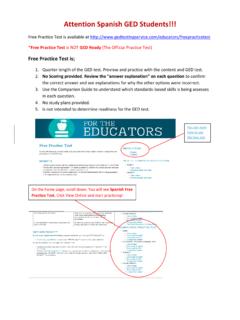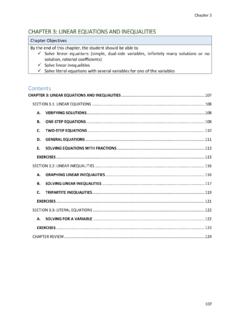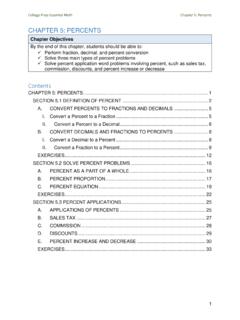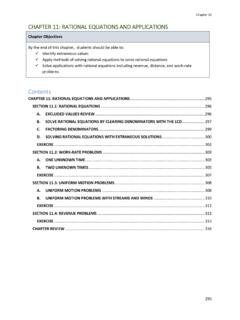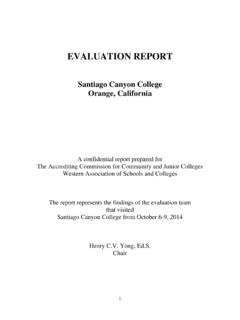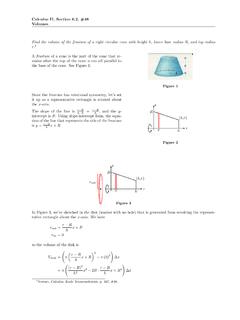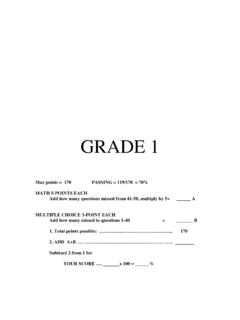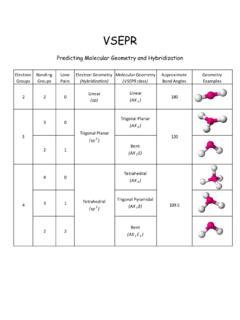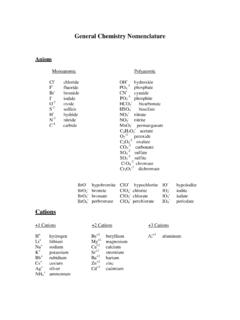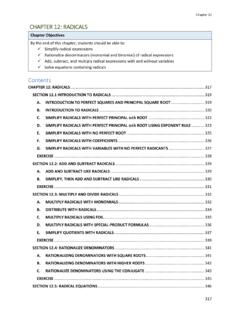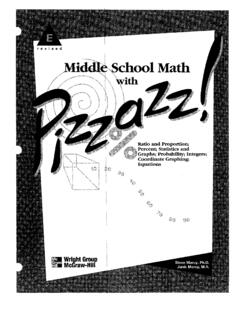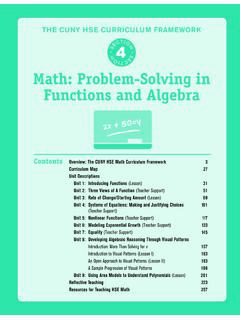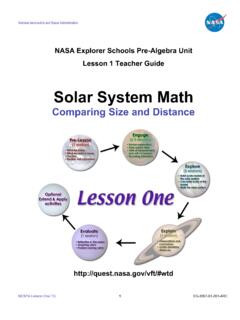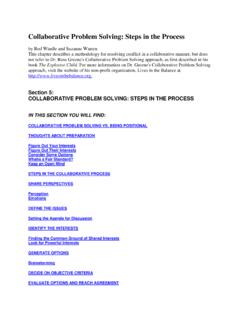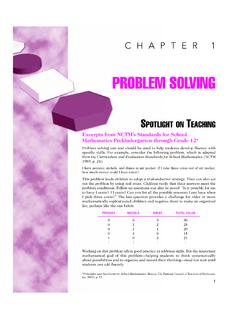Transcription of MATH FOR LIBERAL ARTS STUDENTS - Santiago Canyon …
1 math FOR LIBERAL ARTS STUDENTS DARLENE DIAZ, Santiago Canyon COLLEGE This textbook was originally adapted from David Lippman s math in Society in addition to The Monterey Institute for Technology and Education s content for Geometry and Measurement, Larry Ottman and Ellen Lawsky s content for Normal Distribution, and my own written content to fit the course outline of record. This is the textbook s second edition, where Chapter 5: Measurement and Geometry in version is now two chapters, Chapter 5: Measurement and Chapter 6: Geometry.
2 Exercises were added at the end of Chapter 5 and Chapter 6. Content was added in Chapter 11 for better use of the z-score table (also added at the end of section ) in addition to more exercises at the end of the chapter. The projects written at the end of the textbook are written by me, Darlene Diaz, and can be used in any form as the instructor desires. Supplementary materials listed on page iii can be found in MyOpenMath (or LumenOHM); this includes, Class Notes, the Practice Workbook, online homework exercises and quizzes, and discussion/forums. The Class Notes and Practice Workbook are authored by me, Darlene Diaz.
3 Copyright 2017 Darlene Diaz Version i math FOR LIBERAL ART STUDENTS Table of Contents Chapter 1: problem solving David Lippman 1 Chapter 2: Historical Counting Systems David Lippman, Darlene Diaz 37 Chapter 3: Sets David Lippman 77 Chapter 4: Logic David Lippman 91 Chapter 5: Measurement The Monterey Institute for Technology and Education, Darlene Diaz 114 Chapter 6: Geometry The Monterey Institute for Technology and Education 161 Chapter 7: Finance David Lippman 250 Chapter 8: Statistics, Collecting Data David Lippman, Jeff Eldridge, 281 Chapter 9: Statistics, Describing Data David Lippman, Jeff Eldridge, , Darlene Diaz 301 Chapter 10: Probability David Lippman, Jeff Eldridge, , Darlene Diaz 335 Chapter 11.
4 Normal Distribution Larry Ottman, Ellen Lawsky, Darlene Diaz 379 Solutions to Selected Exercises 423 Index 437 Projects ii Copyright 2017 Darlene Diaz This book was edited, reformatted, and remixed by Darlene Diaz, Santiago Canyon College All chapters contain derived works by David Lippman, Pierce College Ft Steilacoom Development of this book was supported, in part, by the Transition math Project and the Open Course Library Project. Statistics, Collecting & Describing Data, and Probability contain portions derived from works by Jeff Eldridge, Edmonds Community College (used under CC-BY-SA license) (used under public domain declaration) Historical Counting Systems derived from work by Lawrence Morales, Seattle Central Community College (used under CC-BY-SA license) Measurement and Geometry derived from work by The Monterey Institute for Technology and Education, NROC Project, NROC Network, Developmental math program, Unit 6 and Unit 7 (used under CC-BY license)
5 Normal Distribution derived from work by cK-12, Larry Ottman, Ellen Lawsky (used under CC-BY-NC-SA license) This text is licensed under a Creative Commons Attribution-NonCommercial-ShareAlike International (CC BY-NC-SA ) To view a copy of this license, visit or send a letter to Creative Commons, 171 Second Street, Suite 300, San Francisco, California, 94105, USA. You are free: Share copy and redistribute the material in any medium or format Adapt remix, transform, and build upon the material Under the following conditions: Attribution You must give appropriate credit, provide a link to the license, and indicate if changes were made.
6 You may do so in any reasonable manner, but not in any way that suggests the licensor endorses you or your use. NonCommercial You may not use the material for commercial purposes. ShareAlike If you remix, transform, or build upon the material, you must distribute your contributions under the same license as the original. No additional restrictions You may not apply legal terms or technological measures that legally restrict others from doing anything the license permits. With the understanding that: Waiver. Any of the above conditions can be waived if you get permission from the copyright holder.
7 Other Rights. In no way are any of the following rights affected by the license: Your fair dealing or fair use rights; Apart from the remix rights granted under this license, the author's moral rights; Rights other persons may have either in the work itself or in how the work is used, such as publicity or privacy rights. Notice For any reuse or distribution, you must make clear to others the license terms of this work. The best way to do this is with a link to this web page: iii Preface The traditional high school and college mathematics sequence leading from algebra through calculus could leave one with the impression that mathematics is all about algebraic manipulations.
8 This book is an exploration of the wide world of mathematics, of which algebra is only one small piece. The topics are chosen because they provide glimpses into other ways of thinking mathematically, and because they have interesting applications to everyday life. Together, they highlight algorithmic, graphical, algebraic, statistical, and analytic approaches to solving problems. This textbook is meant to expose STUDENTS to different topics in mathematics rather than the usual topics a student usually sees in their mathematical sequence of courses. This textbook is meant to motivate STUDENTS interests in mathematics from a LIBERAL arts perspective and obtain an appreciation for mathematics (or increase it).
9 Each topic is presented in a sufficient amount of depth so that the student has an increased understanding of the history and artistry of mathematics, and the application of these topics to the real-world and everyday life. The applications are extended concepts given through the projects for selected topics in addition to the explorations in selected chapters. Supplements The Washington Open Course Library (OCL) project helped fund the creation of a full-course package for this book in addition to materials authored by me, Darlene Diaz, which contains the following features.
10 Online homework for all the chapters (algorithmically generated, free response) Online quizzes for all the chapters (algorithmically generated, free response) Written assignments and discussion forum assignments for most chapters Class Notes for traditional classes with lectures Practice Workbook for each chapter for in-class (group) assignments Projects based from concepts of selected chapters with real-world applications The course shell was built for the IMathAS online homework platform, and is available for Washington State faculty at and mirrored for others at and Acknowledgements I want to acknowledge my peers at Santiago Canyon College for assisting in version of this textbook.
